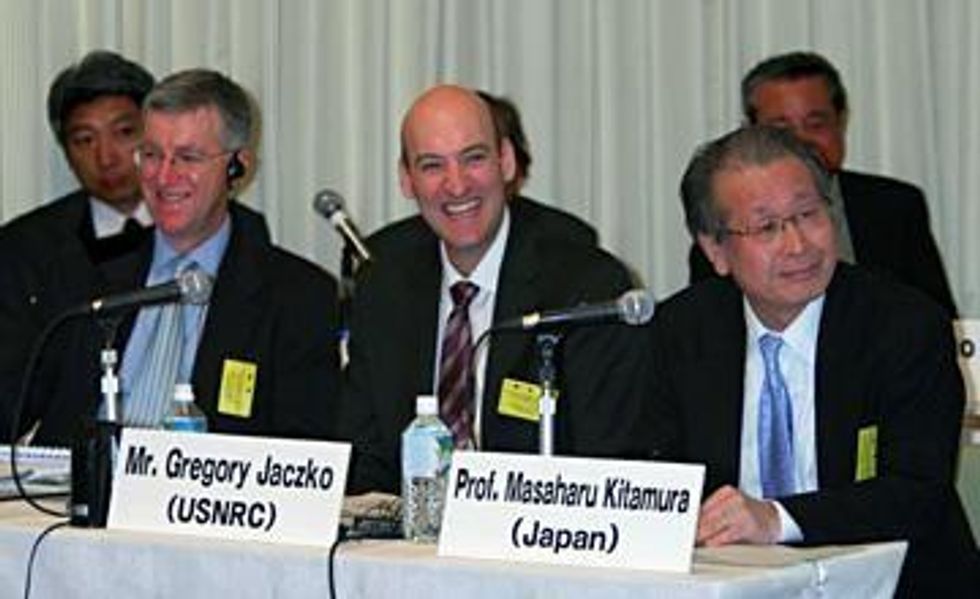Last month, the Massachusetts Institute of Technology (MIT) heralded an Energy Department funded study indicating that evacuation zones around nuclear power stations might not be needed after a major nuclear accident. The study, which exposed mice to radiation levels comparable to those near the Fukushima nuclear disaster, found no evidence of genetic harm. "There are no data that say that's a dangerous level," says Jacquelyn Yanch, a leader of the study. According to the MIT press release "current U.S. regulations require that residents of any area that reaches radiation levels eight times higher than background should be evacuated. However, the financial and emotional cost of such relocation may not be worthwhile, the researchers say."
Even more troubling, the Obama administration reduced emergency preparedness in case of a major nuclear accident in a quiet announcement made six months ago, right before Christmas -- virtually guaranteeing minimal media attention. Given that the number of people living near nuclear stations has grown four-and-a-half times larger since 1980, a move in the opposite direction would make more sense. Yet, the government's low priority for radiation protection is underscored by the Environmental Protection Agency's Inspector General, who recently reported as radioactive fallout from the Fukushima nuclear site drifted over the U.S., 20 percent of EPA's radiation monitoring stations were out of service for more than 6 months.
Also, during early stages of the Fukushima accident, the U.S. Nuclear Regulatory Commission (NRC) officially doubled the baseline annual public radiation dose from the environment by adding medical procedures. According the NRC this dose, " has not been shown to cause humans any harm." Although medical radiation exposures have soared over the past several years, unlike accidental nuclear power releases, an x-ray involves a choice by the patient and doctor. Moreover, in 1970, the world's largest human study of pregnancy x-rays reported that NRC's harmless dose more than doubles the risk of childhood cancer.
Observations based on radiation-exposed humans have long been considered of greater scientific importance, some which were obtained with a callous lack of ethics. In March 1954, after the U.S. exploded an H-bomb in the Marshall Islands that released a roughly comparable amount of cesium-137 as the Fukushima accident, Japanese fishermen and Marshallese were exposed to life-threatening doses of radioactive fallout while forcing Japan to confiscate four million pounds of fish. Two years later, medical advisors to the U.S. Atomic Energy Commission (AEC now DOE) secretly recommended returning the Marshallese people to their homes after being told they would be living in "by far the most contaminated place in the world." At the meeting an AEC expert stated," it would be very interesting to go back and get good environmental data... when people live in a contaminated environment... While it is true that these people do not live, I would say, the way Westerners do, civilized people, it is nevertheless also true that they are more like us than the mice."
Given this well-documented history of deception, why is the government reducing nuclear emergency preparedness and claiming no harm from radiation exposure, right after a major nuclear power disaster? The answer lies in the fact that since the 1940's, the United States remains a major pillar of nuclear support here and around the world. Currently, about 70 percent of the Department of Energy's $26.3 billion budget goes for nuclear activities -- not including $18.5 billion in loan guarantees for new U.S. power reactors being sold by Japan's failing nuclear industry.
The Energy Department is also the main source of funding for radiation health research -- much like having the tobacco industry determine the safety of smoking. This conflict-of interest is not new. Several prominent scientists on the nuclear payroll in the 1950's and 60's vigorously claimed that radioactive fallout from atmospheric nuclear weapons tests was harmless. Some went so far as to assert that fallout might be beneficial because increased radiation-induced genetic mutations could weed out the weak.
This problem was not lost on congressional investigators over the past 35 years. They have revealed the government's suppression of incriminating data, blacklisting of uncooperative researchers, unethical human experiments, and submission of fraudulent research in federal court. By the late 1980's DOE was forced to move funding for radiation research to public health agencies. This all changed 10 years later, when the Republican-controlled Congress restored DOE's monopoly control.
Things have gotten to the point that the agency gave a $1.7 million grant to MIT, last month that will address among other things, the "difficulties in gaining the broad social acceptance" of nuclear power. MIT has also received millions of dollars from Tokyo Electric Power Co (TEPCO), which is responsible for the Fukushima nuclear disaster.
This conflict of interest has tragic dimensions. The government and nuclear industry still face the costly disposal of enormous amounts of radioactive waste and profoundly contaminated "sacrifice zones" at the Energy Department's nuclear sites. Not to mention tens of thousands of sick nuclear workers, uranium miners, military veterans, experiment victims, and nuclear test "down-winders," who are receiving billions of dollars in compensation after being put in harm's way on behalf of splitting the atom.

